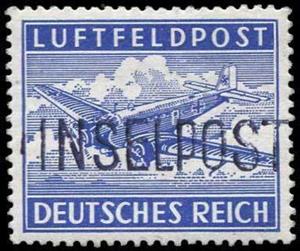Stamp: Plane JU 52 (Austria 1945)
Plane JU 52 (Austria 1945)
01 February (Austria ) within release Plane JU 52 goes into circulation Stamp Plane JU 52 face value None No Face Value
| Stamp Plane JU 52 in catalogues | |
|---|---|
| Michel: | Mi: DR-AT FP11A |
Stamp is square format.
Mi: DR FP11A Used stamp only. Stamp or cut off must bear readable cancellation from Austria during the occupation period or before the expiry date.Also in the issue Plane JU 52:
- Stamp - Plane JU 52 face value None;
- Stamp - Plane JU 52 face value None;
|
Data entry completed
60%
|
|
|---|---|
| Stamp Plane JU 52 in digits | |
| Country: | Austria |
| Date: | 1945-02-01 |
| Print: | Typography |
| Perforation: | comb 13¾ x 14 |
| Emission: | Used Abroad |
| Format: | Stamp |
| Face Value: | None No Face Value |
Stamp Plane JU 52 it reflects the thematic directions:
An aircraft (pl. aircraft) is a vehicle that is able to fly by gaining support from the air. It counters the force of gravity by using either static lift or the dynamic lift of an airfoil, or, in a few cases, direct downward thrust from its engines. Common examples of aircraft include airplanes, rotorcraft (including helicopters), airships (including blimps), gliders, paramotors, and hot air balloons.Part 1 (Definitions and Abbreviations) of Subchapter A of Chapter I of Title 14 of the U. S. Code of Federal Regulations states that aircraft "means a device that is used or intended to be used for flight in the air."
Aviation is the practical aspect or art of aeronautics, being the design, development, production, operation and use of aircraft, especially heavier than air aircraft. The word aviation was coined by French writer and former naval officer Gabriel La Landelle in 1863, from the verb avier (synonymous flying), itself derived from the Latin word avis ("bird") and the suffix -ation.
In meteorology, a cloud is an aerosol consisting of a visible mass of miniature liquid droplets, frozen crystals, or other particles suspended in the atmosphere of a planetary body or similar space. Water or various other chemicals may compose the droplets and crystals. On Earth, clouds are formed as a result of saturation of the air when it is cooled to its dew point, or when it gains sufficient moisture (usually in the form of water vapor) from an adjacent source to raise the dew point to the ambient temperature.



